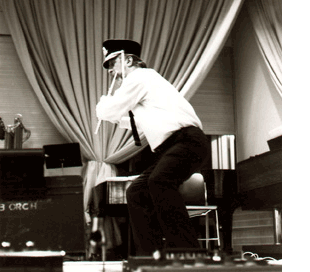 Robert B. Cantrick (1917-2006) was born and grew up in Monroe, Michigan.
He received his BA in flute from the University of Rochester, his MA in
philosophy also from the University of Rochester after graduate study at
Harvard, and his PhD in composition from the University of Iowa after study
at Oberlin College and the University of Michigan. In 1943 he married
Margaret Gesell (1916-2001, also of Monroe), with whom he had six children.
During World War II, Cantrick served in the Third Army as both soldier and
band conductor in France, Belgium, the Netherlands, and Germany. After the
war, he was active as a conductor for more than a decade, during which
time he founded the Greenville Symphony Orchestra (Greenville, South Carolina),
studied as an apprentice conductor under George Szell with the Cleveland
Orchestra, and served on the conducting staffs of Carnegie Mellon University
and the Juilliard School of Music. While at Carnegie Mellon, he located
the lost manuscript of Gustav Holst's
Hammersmith and restored it to the concert-band
repertoire. Subsequently, he taught at Jacksonville State University in
Jacksonville, Alabama, and served as dean of fine arts at Wisconsin State University
in Stevens Point. In 1967 he became director of arts and humanities at Buffalo
State College (Buffalo, New York), where he was also professor of music from 1969
until he retired in 1985. Remaining active professionally after his retirement, he
continued research and development of his two-volume scholarly work,
Semantics
of Music Scholarship, incomplete at the time of his death.
Robert B. Cantrick (1917-2006) was born and grew up in Monroe, Michigan.
He received his BA in flute from the University of Rochester, his MA in
philosophy also from the University of Rochester after graduate study at
Harvard, and his PhD in composition from the University of Iowa after study
at Oberlin College and the University of Michigan. In 1943 he married
Margaret Gesell (1916-2001, also of Monroe), with whom he had six children.
During World War II, Cantrick served in the Third Army as both soldier and
band conductor in France, Belgium, the Netherlands, and Germany. After the
war, he was active as a conductor for more than a decade, during which
time he founded the Greenville Symphony Orchestra (Greenville, South Carolina),
studied as an apprentice conductor under George Szell with the Cleveland
Orchestra, and served on the conducting staffs of Carnegie Mellon University
and the Juilliard School of Music. While at Carnegie Mellon, he located
the lost manuscript of Gustav Holst's
Hammersmith and restored it to the concert-band
repertoire. Subsequently, he taught at Jacksonville State University in
Jacksonville, Alabama, and served as dean of fine arts at Wisconsin State University
in Stevens Point. In 1967 he became director of arts and humanities at Buffalo
State College (Buffalo, New York), where he was also professor of music from 1969
until he retired in 1985. Remaining active professionally after his retirement, he
continued research and development of his two-volume scholarly work,
Semantics
of Music Scholarship, incomplete at the time of his death.
Throughout the years, Cantrick held a number of professional honors: he was a
grantee of the Carnegie Foundation, a fellow of the Berkshire Music Center, a Ford
Foundation fellow, and a SUNY Research Foundation fellow. His articles appeared
in The American Sociological Review, The Journal of General Education,
The Quarterly of Film, Radio and Television, The Journal of Aesthetics and Art
Criticism, Music and Letters, and The British Journal of Aesthetics.
As a composer, Cantrick produced symphonic, vocal, and chamber music. He was a
pioneer in the development of extended flute techniques, which are showcased in
his work Three Mimes for flute and baritone voice. Of the premiere performance
of this work in 1994, the
New York Times wrote, "Mr. Cantrick tells us among other
things that mime is neither speechless nor silent, but simply another way of making
conversation. Love stories and personal anguish, he seems to add, can have a
coherence even when the words used to utter them don't." His most frequently
performed compositions are Three Mimes, Trio for violin, viola and cello,
The Friendly Beasts, a song cycle for mezzo-soprano and orchestra,
and E.T.O.,
Rhapsody for Dance Band and Symphony Orchestra. E.T.O. was premiered in
1987 by the Buffalo Philharmonic Orchestra under Lukas Foss and was
performed twice by the Greenville Symphony Orchestra for the opening of its 60th
anniversary season in September 2007.
|
© 2007 The Robert B. Cantrick Estate
All rights reserved
No part of this publication may be reproduced or distributed in any form or
by any means,
or stored in any data base or retrieval system, without prior
written permission of the publishers.
|